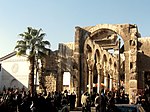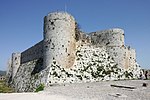
Krak des Chevaliers, Arabic: قلعة الحصن, romanized: Qalʿat al-Ḥiṣn also called Hisn al-Akrad and formerly Crac de l'Ospital; Krak des Chevaliers or Crac des Chevaliers, is a medieval castle in Syria and one of the most important preserved medieval castles in the world. The site was first inhabited in the 11th century by Kurdish troops garrisoned there by the Mirdasids. In 1142 it was given by Raymond II, Count of Tripoli, to the order of the Knights Hospitaller. It remained in their possession until it fell in 1271.

Sahyun Castle, also known as the Castle of Saladin, is a medieval castle in northwestern Syria. It is located 7 km east of Al-Haffah town and 30 km east of the city of Latakia, in high mountainous terrain on a ridge between two deep ravines and surrounded by forest, the site has been fortified since at least the mid 10th century. In 975 the Byzantine Emperor John I Tzimiskes captured the site and it remained under Byzantine control until around 1108. Early in the 12th century the Franks assumed control of the site and it was part of the newly formed Crusader state of the Principality of Antioch. The Crusaders undertook an extensive building programme, giving the castle much of its current appearance. In 1188 it fell to the forces of Saladin after a three-day siege. The castle was again besieged in 1287, this time both defender and belligerent were Mamluks. In 2006, the castles of Qal'at Salah El-Din and Krak des Chevaliers were recognised as a World Heritage Site by UNESCO. The site is owned by the Syrian government.

Marmarita is a village in northwestern Syria, located west of Homs. Marmarita is one of the largest villages in Wadi al-Nasara, a region north of Talkalakh. In 2004, Marmarita had a population of 2,206, according to the Central Bureau of Statistics (CBS). Its inhabitants are predominantly Greek Orthodox and Greek Catholic Christians and is one of the largest Christian villages in the Wadi al-Nasara. Marmarita is a popular summer destination and tourist attraction in Syria. The village has been part of the Homs Governorate since 1953; prior to that, it was part of the Latakia Governorate. The village has three Greek Orthodox Church, a Greek Catholic Church and a Protestant Church.

The National Museum of Damascus is a museum in the heart of Damascus, Syria. As the country's national museum as well as its largest, this museum covers the entire range of Syrian history over a span of over 11 millennia. It displays various important artifacts, relics and major finds most notably from Mari, Ebla and Ugarit, three of Syria's most important ancient archaeological sites. Established in 1919, during King Faisal's Arab Kingdom of Syria, the museum is the oldest cultural heritage institution in Syria.

The Ancient City of Bosra is an archaeological site located in the city of Bosra, Syria. The site illustrates the Roman, Byzantine and Muslim civilizations, and is inscribed by UNESCO in the list of World Heritage.

Although Syria has some of the oldest cities in Western Asia, such as Damascus and Aleppo, tourism in Syria has greatly reduced as a result of the Syrian War, that began in 2011 and is ongoing, and its associated refugee crisis. Tourism has been further impacted by the outbreak of COVID-19 starting in March 2020. The international economic sanctions imposed on Syria and the sharp drop in the value of the Syrian pound also adversely impact tourism in Syria. The Ministry of Tourism is the responsible government department.














